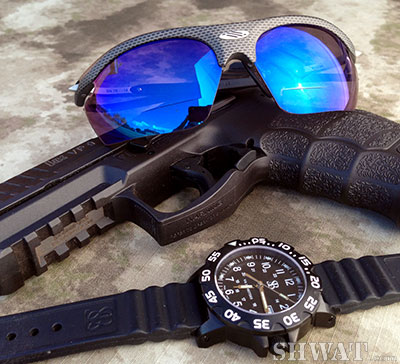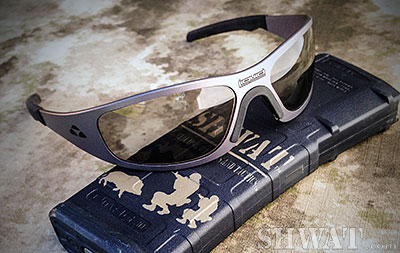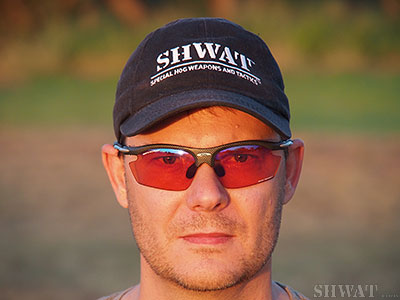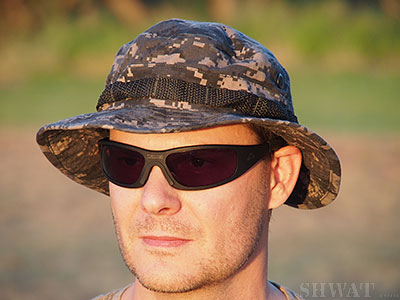
If you have eyeballs, you need to read this. In my quest to identify and then tell you about the one best hunting and shooting eye protection option available, I have to admit failure here at the start. But not for lack of trying. Severely near sighted since childhood, I’ve gone from almost legally blind through Lasik eye surgery to excellent vision; I’ve field tested numerous pairs of glasses; I’ve talked to multiple labs and docs of all stripes. In the end, I’ve learned enough to write a small book. Distilling that down to something I think you’d like to read and will benefit from has been tricky. When you’re done with this, I hope I’ll have impacted the way you think about eye protection and given you some direction on getting what you need.
We take our eyes for granted most of the time. But did you know that at birth your eyes are basically full sized and your skull grows around them? Or that your optic nerves have roughly a billion connections into your brain transmitting an inverted image the computer between your ears then has to sort out? Eyes are worth protecting, yet it seems like more people take this seriously in the target shooting and training communities than in the hunting community. Given the terrain, hiking, vehicles and movement of the hunting world, this seems backwards to me. The worst thing that’s happened to me on a range was a piece of 45 ACP hot brass oddly deflected from my 1911 hitting the underside of my hat brim, then slipping between my glasses and eyelid before falling to the ground. That could be pretty ugly, but I’m a lot more likely to take a mesquite tree to the eyes where I often hunt.
 Your choice in ballistic eye protection will factor in any number of priorities. The level of “ballistic” protection is an obvious one. There are a number of good options available, but getting past the marketing of sub par products to the real deals can be tricky. Manufacturers throw around phrases like “milspec” and “ballistic” to impress us. They might back up that claim with an ANSI Z87.1 rating. Here’s the problem with that “Ballistic” rating: A Red Ryder BB gun could well be capable of putting a .177 caliber steel BB right through an ANSI Z87.1 certified lens. The fact is that this most basic ballistic certification is really designed to mitigate workplace hazards – far cry from milspec. Eyewear maker Smith Optics calculated the difference between the ubiquitous ANSI Z87.1 certification and milspec standards. By their numbers, Milspec is 660% harder to achieve. The difference is real.
Your choice in ballistic eye protection will factor in any number of priorities. The level of “ballistic” protection is an obvious one. There are a number of good options available, but getting past the marketing of sub par products to the real deals can be tricky. Manufacturers throw around phrases like “milspec” and “ballistic” to impress us. They might back up that claim with an ANSI Z87.1 rating. Here’s the problem with that “Ballistic” rating: A Red Ryder BB gun could well be capable of putting a .177 caliber steel BB right through an ANSI Z87.1 certified lens. The fact is that this most basic ballistic certification is really designed to mitigate workplace hazards – far cry from milspec. Eyewear maker Smith Optics calculated the difference between the ubiquitous ANSI Z87.1 certification and milspec standards. By their numbers, Milspec is 660% harder to achieve. The difference is real.
 Optics are another big priority. After Lasik, the first pair of sunglasses I put on were branded “Harley Davidson.” Since they were purchased from a prescription eyeglass retailer, I was surprised to find I could see better without them. As a photographer and videographer, I knew optics mattered, but didn’t realize the significant difference in non-prescription eye wear. The same is true for eye protection. Clarity matters, and the best will cost above average.
Optics are another big priority. After Lasik, the first pair of sunglasses I put on were branded “Harley Davidson.” Since they were purchased from a prescription eyeglass retailer, I was surprised to find I could see better without them. As a photographer and videographer, I knew optics mattered, but didn’t realize the significant difference in non-prescription eye wear. The same is true for eye protection. Clarity matters, and the best will cost above average.
Beyond the level of protection and optical clarity, size matters. The bigger the lens or shield, the more visibility increases. Get big enough and comfortable enough and you’re essentially unaware of the ballistic glasses on your face. That’s all well and good, but pulling the brim of a hat down becomes difficult. And that can mean the sun in your eyes…
For this review, I’ve narrowed the field to three brands, an all around winner and two specialized options. Each set of eye pro is a winner in its own right.
 Rudy Project – Rydon Shooting Glasses
Rudy Project – Rydon Shooting Glasses
Thank you July Golob for introducing me to Rudy Project glasses! My all around top choice for ballistic shades are the Italian Rudy Project Rydon Shooting glasses. The Impact X lenses are remarkable. They should be, as they are made of the same material as Apache helicopter windshields. The lenses are literally flexible, yet very tough to bend. Optically they are as good as you can imagine given their pedigree. Important to me is the availability of reader lenses built in. They will set you back a couple of hundred dollars and for a nominal fee you can exchange lenses under either their Lifetime or one year replacement policy, depending on whether you have regular, prescription or reader lenses. I’ve enjoyed training with these.
The Racing Red Lenses I have are fantastic in any light. After a brief moment where my brain recalculates white balance, all I notice is the warm, high contrast sharp field of view. Switching to my Laser Blue lenses gives me very true to life colors. As an added bonus, Rudy Project shades are used by tons of high performance endurance athletes. My wife is one of those nationally competitive types, and I at least look the part hanging with her and her racing pals wearing my Rudys!
 Smith Optics – Aegis Echo
Smith Optics – Aegis Echo
Whether hunting or training, I often find myself wearing my trusty Howard Leight Impact Sport muff style hearing protection. Wearing eye pro under muffs can open a gap where the glasses temples go under the ear muff seal. That can compromise the sound insulating quality of the muff. Not acceptable in my book. The Smith Optics Aegis Echo is hands down the best solution I’ve found. The temples are made of alloy, and super thin. Bend them around your head behind the ears for the ultimate fit. I have the field kit with clear and gray lenses, but yellow and red lenses are available, too. All are true milspec, all block 100% UVA/UVB, and all have anti fogging properties. Pigs have died while I’ve worn these. If you wear muffs over your ears for hearing protection, you really should own a pair of these. Smith Optics knows how to drive the value equation. The Aegis Echo is only a hundred bucks.
 Liquid Eyewear – Gasket
Liquid Eyewear – Gasket
Liquid shades live in a category of their own. First off, they may well have the coolest name in the business. Beyond that, the most obvious feature is the durable, lightweight aluminum frame with no hinges. The lack of hinges results in a fashion forward look that apparently Travis Haley couldn’t resist. The ultimate wrap around shades, these are popular with sky divers and can be configured as prescription glasses or readers.
Liquid is well known for the polarized lenses, but I’ve been most impressed with their Hellfire “light to dark” technology. I’ve always been a skeptic of transition type lenses, but these really work. I’ve been hunting in the afternoon and remained out past dark, donning a helmet and PVS-14 night vision. The Hellfire lenses were dark enough in the day, and clear enough at night to work perfectly. I even wear them when flying my drone as the sun slips below the horizon.
A word of advice, choose carefully the frames you get. I got the Gasket frames, but it seems that despite my brother and fellow SHWAT™ founder’s suspicions, I don’t have a big head. At least not big enough for the Gasket frames. I probably should have gone with the players. A pair of these will run $150+ depending on lenses.
So here’s the deal – your eyes are amazing, designed to function remarkably well without a lens in front of them. Even given the pathetic vision I dealt with virtually my whole life up until last January, I now appreciate how complex it is to build a set of glasses that actually works with optical clarity, comfortable design, and good looks. Yes, a good pair of these will set you back more money than something at the convenience store, but your eyes are worth it. An eye injury could really mess up your quality of life. Invest in some good eye protection. I’ve never heard anyone express regret over that move.

